-

人教版新目标初中英语八年级下册It’s a nice day, isn’t it教案2篇
"Hello! Welcome to English class! Introduce yourself. Meet your new classmates." That's what the teacher says. What do you say? "Oh no!" It can be difficult talking to new people. But it can be fun, and you can make friends. How do you do it? Make small talk. Small talk is polite conversation. "Wang Nan is a great pingpang player, isn't she?" "I'd love to meet her, wouldn't you?" "It's been raining a lot, hasn't it?" Tag questions are a form of polite speech. To make small talk successfully, you should know how to make them. You should also know what topics to talk about. Try to learn this unit carefully. The next time you're in English class, you'll find out. Making small talk's easy, isn't it? (“你好!欢迎你!请做一下自我介绍。认识一下你的新同学。”通常在课上老师会这样说。你会说什么呢?“噢,不!”与陌生人谈话太困难了。但是这也很有意思,并且你还能交到朋友。你该怎么做呢?闲聊。闲聊指得是礼貌的对话。“王楠是一个很棒的乒乓球运动员,不是吗?”“我希望自己能认识她,你呢?“今年的雨水很多,不是吗?”反意疑问句是一种礼貌用语。为了使得谈话成功,你应该知道怎样去进行闲聊。你还应该知道与不同的人该谈论什么样的话题。认真的学习这个单元吧,下次在英语课上,你会发现与大家展开谈话是一件很容易的事情,不信我们来试试。)

人教版新目标初中英语七年级下册Where is the post office教案2篇
Period 2 (3a----Section B 2c)Preview(Pre-task): Key points: What laAdd another information about their pen pals----their language on the cardnguage does she/he speak?She/He speaks....Does she/he have any brothers and sisters? Does she/he speak English?Preview(Pre-task): Add another information about their pen pals----their language on the cardKey points: What language does she/he speak?She/He speaks....Does she/he have any brothers and sisters? Does she/he speak English?Step 1 Revision1.Revisionand dictation of the new words 2.Revise the drills they learned yesterday.(by pairwork and grammar exercise)Step 2 Leading-inT has a conversation with one student. The conversation is following:---Do you have a pen pal?---Yes, I do.---What's your pen pal's name? ---His/Her name is....---Where is your pen pal from? ---He/She is from...---Where does he/she live? ---He/She lives in....---What language does he/she speak?He/She speaks...Write the new words on the Bb. They are following: EnglishChineseJapaneseFrenchStep 3 LearnLearn the new words with the whole class.Finish 3a with the students3b Pairwork T still does an example with one student Then the Ss practise in pairs. The example is following:--Curry Muray is my pen pal. He is from the United States.---What language does he speak?

人教版新目标初中英语七年级下册I want to be an actor教案2篇
三、教学建议第一课时:1. Lead in (Vocabulary)A) Before class, teacher should collect some pictures of working places. For example: Bank, TV Station, Restaurant, Police Station, Hospital ...B) In class, show students the pictures (PowerPoint, OHP). Ask students to tell the name of the working places and the name of the jobs.Shop assistant, doctor, actor, reporter, police office, waiter, bank clerk, studentC) Do exercise 1a and 3a.2. Bingo GameAsk groups of students to make up pairs of cards with a job on one and the related workplace on the other. For example, waiter / restaurant, teacher / school, doctor / hospital. Encourage students to use both the job / workplace combinations in the book and the ones that students came up during class discussions. Be sure they have twice as many sets of cards as there are students in the group. They can make two sets of cards for a single job / workplace, if necessary. Then have each group mix up its set of cards and hand their cards out in random order. Each time a student gets a pair of cards that match, he or she can lay these cards down. The goal is to have no cards in your hand at the end.3. Task OneA) Ask students to work in pairs and ask the partner what does he / she want to be in the future.e. g. :What do you / does he / does she want to be?I want to be a.Why?Because it's (adj).B) Vocabulary: Section B, 1a4. Homework 1.2.

人教版新目标初中英语七年级下册Why do you like koalas教案2篇
单元整体说明(一)单元教材分析本单元的核心话题是描述动物和表达个人喜好,以及句式why do you like…? Because…。这也是本单元的教学重点。通过本单元的学习,学生应能较流利地运用所学词汇和句型描述动物,表达个人喜好。(二)单元知识结构1.词汇动物名称 tiger, elephant, koala, dolphin, etc.词汇描述性形容词: smart, cute, ugly, clever, shy, etc.国家名: Australia, South Africa2.句型Why do you like koala hears? Because they are cute.Where are pandas from? They're from China.What animals do you like? I like dolphins.(三)单元整体目标1.Master the vocabulary2.Master and use: Why do you like koalas? Because they am cute.Where are pandas from? They're from China.What animals do you like? I like dolphins.(四)单元教学重难点一览(五)单元学情分析学生此前已经学过由why, where, what 引导的特殊疑问句句型,具有了学习本单元知识的认知前提。形形色色的动物能激发学生的好奇心,产生了解它们的欲望,这有利于本单元知识的教学和学生学习兴趣的培养。

人教版新目标初中英语八年级下册He said I was hard-working教案2篇
This activity introduces some new vocabulary and provide oral practice using the target language.Task 1 . Ask four students to stand in front of the class, and the teacher asks them the following questions as a reporter.1.What are you going to do when you grow up?2.What are you going to do next week?3.What are going to do after school?The students will give different answers, then ask a good student to report what they said.I am going to e a doctor.What did she say?----------She said she was going to be a doctor.I am going to have a party on Friday night.What did he say?-------He said he was going to have a party on Friday night.I am going to do my homework.What did she say ?------ She said she was going to do her homework.I am going home after school.What did she say?-----She said she was going home after school.Say In this unit we are going to learn to use words like to report what someone said.Task 2. Read the instructions. Then ask a student to read the four questions. And write the words on the Bb. Explain what soap opera is.Task 3. Ask the students to Look at the pictures, point out the TV screens in the picture. Ask one girl to read what Marcia said.What did Marcia say? She said She said she was having a surprise party for Lana on Friday night. Repeat the other pictures in the same way.Activity3. Listen and number the pictures in activity 1a.

人教版新目标初中英语八年级下册How long have you been collecting shells教案2篇
Step Ⅱ Show the new words on the screen and teach the new words. Read the new words to students and ask them to repeat.Step Ⅲ 3aThis activity introduces new vocabulary and provides reading practice using the target language.In this activity first look at the four pictures.T: What can you see in the pictures?Ss: Four snow globes.T: Right. There are four snow globes in the pictures. And what are they?Ss: They are a monster, two polar bears, two penguins and a birthday cake.Write these words on the blackboard: snow globe; monster; polar bear; penguin and birthday cake. Read them to the class and ask students to repeat each one. Make sure students understand each word.Use a computer to show the E-mail message on the screen and read the message to students.Get students to read the e-mail on their own, and then draw lines connecting each snow globe and its description.Correct the answers.AnswersA line should connect each snow globe picture with the words that describe it in the letter.Step Ⅳ 3bThis activity provides writing practice using the target language.First review Activity 2a on Page 47.Then ask students to complete the message according to Activity 2a.Some partial sentences are given to students. Write about one person's collection.When students work, walk around the room checking the progress and offering help as needed.When they finish, ask some students to read their messages to the class.

人教版新目标初中英语八年级下册What were you doing when the UFO arrived教案2篇
(一).知识方面: 1.培养学生能运用过去进行时来描述、谈论过去某个时间正在发生的事情或动作的意识和能力,能就过去某个时间正在发生的动作做出正确的描述。 2.培养学生的想象力和角色扮演的合作能力。 3.培养学生讲述过去发生的事情经过的能力。能正确运用一般过去时来讲述故事。 (二).技能方面: 1.本单元的语言目标是Talk about past events and tell a story(谈论过去的时间和讲述一个故事),围绕这一目标,要涉及句型: What were you doing when the UFO arrived? ----I was sitting in the barber’s chair. The barber was cutting my hair. 因此必须学习standing、studying、cleaning、sleeping、cooking、making、eating、cutting、等表示地点的词,以便为上述句型提供语言材料。2.学习过去进行时的有关知识。Was/were+现在分词,是该时态的表达式。 3.在学习过程中,要区分The boy was walking down the street when the UFO landed.和While the boy was walking down the street, the UFO landed.这两种由when和while引导的状语从句的句型结构。注意它们的不同。

人教版新目标初中英语七年级下册How was your weekend教案2篇
Teaching Goal:1. General aims:Talk about recent past events2. Particular aims:A. Language Focus.Talk about recent past events and think of the past events.B. Language goalsHow was….?It was …What did …do over the weekend?C. Language structures:(1). How was your weekend? I was great. Pay attention to no form.(2). What did you do over the weekend? I played soccer. We went to the beach.D. Useful words and phrases:Words: was, did, went, beach, over, project, test, wasn’t, false, number, geography, spend, week, most, mixture, their, had, little, cook, read, saw, change, everyone, sit, sat, no, anythingPhrases: did one’s homework, played soccer, cleaned my room, went to the beach, played tennis, went to the movies, on Saturday morning, over the weekend, cook … for, what about, do some reading, have a party, talk show, go shoppingE. Grammar language:Present simple past tenseRegular and irregular verbsF. Learning strategies:Tour and holidaysG. Interdiscipinary:H. Emotion and manner:Teaching time: 5 periodsTeaching procedures:Period One教学步骤、时间 教师活动 学生活动 媒体应用Step 1Free talk 3’ Ask some questions like:Who’s on duty today?What’s the weather like? Answer and talk about something.让同学们回答下列问题1. Do you like weekend? (Let some students answer)It takes them three minutes to talk about the question.2. Why do you like weekend? (let the students answer) Most of the students like the weekend此时教师用汉语问:“在周末期间问你干了什么?这句话用英语这么回答?Let the students guess.At last the teacher give them right answer3. What did you do over the weekend?(板书、学习)

人教版新目标初中英语九年级下册We’re trying to save the manatees教案2篇
本单元主要围绕着有关濒临灭绝的动物这一话题,学习了应该怎样保护我们的环境,以及就某一问题展开辩论。目标提示语言目标能够运用所学知识,就某一问题展开辩论。认知目标1、复习一些语法:现在进行时、一般现在时、用used to 表示一般过去时、现在完成时、一般过去时的被动语态。2、学会表达同意和不同意。3、学会以下基本句型:We’re trying to save the manatees.Manatees eat about 100 pounds of food a day.There used to be a lot of manatees.In 1972,it was discovered that they were endangered.Some of the swamps have become polluted.情感目标了解一些濒临灭绝的动物的生活习性和濒临灭绝的原因,教育学生应该如何保护环境。教学提示充分利用多媒体等教学设备,创设与本课话题相关的情境,如各种不同种类的动物、动物园以及有关环境的画画等等。围绕着本单元的教学目标,设计一些贴近学生实际的教学任务,如让学生谈论自己最喜欢的动物,如何拯救濒危动物,如何保护环境等等。让学生根据所学知识,就动物园是否对动物有利以及其他的话题进行辩论。
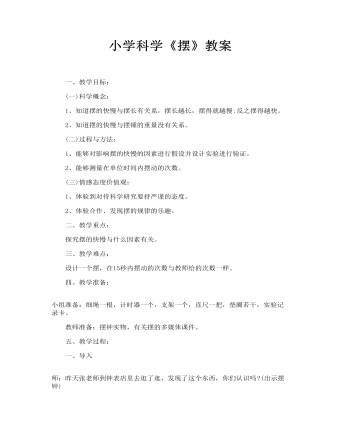
小学科学《摆》教案
(二)过程与方法: 1、能够对影响摆的快慢的因素进行假设并设计实验进行验证。 2、能够测量在单位时间内摆动的次数。 (三)情感态度价值观: 1、体验到对待科学研究要持严谨的态度。 2、体验合作、发现摆的规律的乐趣。
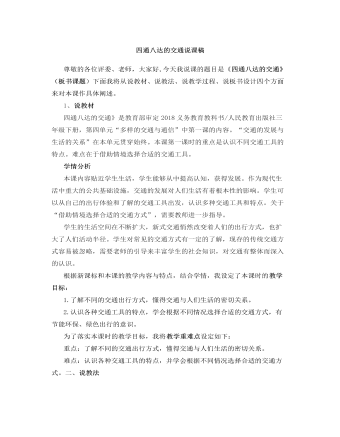
人教部编版道德与法制三年级下册四通八达的交通说课稿
1.宇涵同学音频说出自己出行困扰。2.小组合作讨论设计往返旅游线路:宇涵同学渴望大家的帮助,就请小组成员一起合作,帮宇涵设计一份往返旅游线路,我这里有一份从南京到大连的不同交通工具所需时间及费用的参考表。小组讨论,并将小组一致认为最适合的设计方案,写在设计表中!3.各小组派代表分享设计方案4.设置情境,学以致用:同学们设计的方案都很好,如果从我们目前所在的城市,到宇涵的家乡“南京”你又会如何选择?5.小结:看来,同学们都能根据自己不同的需求选择合适的出行方式。活动二:了解传统交通方式的作用1.观察思考:在我国,一些地区至今还沿用着传统的交通工具(出图),大家仔细观察,想一想,为什么它们能沿用至今?你还知道哪些传统的交通工具?2.小结:是呀,无论时代如何变迁,现代交通工具多么发达,都要选择适合我们的交通工具。在享受它们带来的便捷时,做到绿色出行,减少拥堵污染,那我们的生活一定会更加美好。
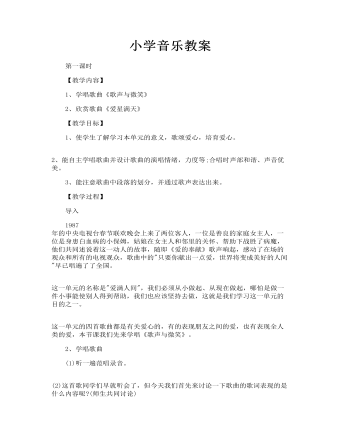
小学音乐教案
1、使学生了解学习本单元的意义,歌颂爱心,培育爱心。 2、能自主学唱歌曲并设计歌曲的演唱情绪,力度等;合唱时声部和谐、声音优美。 3、能注意歌曲中段落的划分,并通过歌声表达出来。 【教学过程】 导入 1987 年的中央电视台春节联欢晚会上来了两位客人,一位是善良的家庭女主人,一位是身患白血病的小保姆,姑娘在女主人和邻里的关怀、帮助下战胜了病魔,他们共同述说着这一动人的故事,随即《爱的奉献》歌声响起,感动了在场的观众和所有的电视观众,歌曲中的"只要你献出一点爱,世界将变成美好的人间"早已唱遍了了全国。
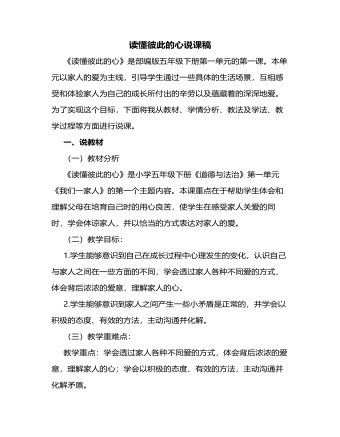
人教部编版道德与法制五年级下册新版读懂彼此的心说课稿
(二)理性面对:交流方式多。1、其实,遇到问题并不可怕,办法总比困难多。2.阅读王玉理的故事,你受到哪些启发?3.交流方式有很多:如写信、留言条等。4.情景出示:班里很多学生都可以用钢笔书写了,由于我写字漏字错字现象多,老师让我再练练,可是妈妈觉得是我写字写得不好。我认为这明明是两个问题,妈妈的误解让我很不开心。如果是你,你会怎么做呢?选择合适的方式,试着主动和妈妈交流沟通吧。(三)我爱家人:发现父母的美。1、小组内合作,阅读课前小调查“我眼中的父母别人眼中的父母”,说说有什么新的发同伴身上学现?2.列举事例说说父母身上的父母的闪光点,交流自己的感受。3.教师总结。(四)拓展延伸:布置活动作业。1.布置课后活动作业。2.小结:明确下节课学习内容。

人教部编版道德与法制五年级下册新版建立良好的公共秩序说课稿
教师小结:同学们,通过刚才的讨论,我们明白了只有大家共同遵守规则,才能创造和谐文明的社会环境,正如著名学者莱蒙特所说的:“世界上的一切都必须按照一定的规矩秩序各就各位。”(六)、课堂总结师:通过今天对《建立良好的公共秩序》这一课的学习,我们懂得了什么?在生回答的基础上师进一步谈话:生活中有许多看起来是微不足道的事情,实际上都同社会的主产、生活乃至每个社会成员的工作、学习、生活密不可分,如果一个社会的公共秩序受到了破坏,这个社会的正常生产和生活也就受到极大的影响,社会风气就会颓败,反之如果一个社会的每个成员都学法、懂法、守法、护法,拥有一个良好的公共秩序,那么社会就会有条有理,井然有序,因此建立一个良好的社会公共秩序,是我们大家的迫切希望,希望同学们从我做起,从现在做起,认真遵守公共秩序吧!
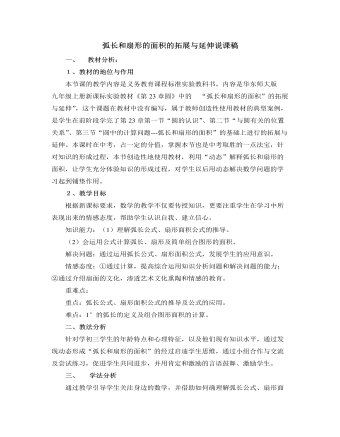
北师大版初中数学九年级下册弧长和扇形的面积的拓展与延伸说课稿
五、教学反思:时钟的秒针、分针、时针扫的图形, 汽车挡风玻璃的刮水器;刷工人刷过的面积近似看为扇形。圆中的计算问题---弧长和扇形的面积,虽然新课标、新教材要求学习,但本节教师结合学生的实际要求,将其作为内容进行拓展与延伸,具有一定的实际意义。用生活中动态几何解释扇形,体验解决问题策略的多样性,发展实践能力与创新精神。本节课,教师通过“扇子”的问题情景引入新课,它蕴含了大量的情感信息,有效激发学生的求知欲望,充分调动学生的学习积极性,注重学生的参与,让出时间与空间由学生动手实践,鼓励学生自主探索、合作交流、展示成果,提高了学生发现问题、提出问题、解决问题的能力。用“扇子变化”,帮助学生探索自然界中事物的动静结合问题,利用“扇子的文化”的新奇感激起学生的学习热情,陶冶了学生的学习情操,从而使学生更深切地理解问题,使原本单调枯燥的数学变得生动、形象,激发学生的情感,使课堂充满生机。

人教部编版道德与法制二年级下册学习有方法说课稿
设计意图:发现身边更多的学习好方法。活动三:巩固学习的好方法课件出示儿歌《学习好方法》,学生填空后,齐读儿歌。设计意图:学以致用,巩固学习的好方法。环节三:感悟明理,育情导行学生谈一谈学习本节课的收获,教师相机引导。设计意图:梳理总结,体验收获与成功的喜悦,内化提升学生的认识与情感。环节四:拓展延伸,回归生活以小组为单位,将各组总结的学习好方法张贴到板报上。设计意图:将课堂所学延伸到学生的日常生活中,有利于落实行为实践。六、板书设计为了突出重点,让学生整体上感知本节课的主要内容,我将以思维导图的形式设计板书:在黑板左面的中间位置是课题《学习有方法》,右面从上到下依次是专心听讲、细心观察、珍惜时间、持之以恒、节约时间。

人教部编版道德与法制三年级下册同学相伴说课稿
一、教材分析《同学相伴》是统编教材小学《道德与法治》三年级下册第一单 元第 4 课,共有两个话题,本节课学习的是第一个话题《同学相伴的 快乐》,主要是引导学生体会同学在一起共同游戏、共同生活中的快乐,旨在引导学生愿意与同伴在一起,体会乐群的意义。 二、学情分析三年级的学生在两年半的校园生活中,在与同学相伴方面,已经积累了较多的生活经验和体验,但他们还不能从理性上理解共同生活对于个体的意义。因此,要通过有效的教学,帮助引导学生体会同学相伴的快乐和乐群的意义。三、教学目标与重难点 基于教材、学情的分析,以及对小学道德与法治课程的理解,我确定了本节课的教学目标与重难点。教学目标我确定了三个。1. 体会同学相伴的快乐。2. 懂得同学相伴的重要性。3. 乐于在生活中与同学合作、分享。教学重点是:体会同学相伴的快乐和乐群的意义。

人教部编版道德与法制六年级下册学会反思说课稿
1、说教材本课是第一单元“完善自我 健康成长"的第3课,本课是在前 五年我的健康成长主题学习的基础上,聚焦反思。本课包括“生活离 不开反思"和“养成反思好习惯"两部分内容。教学时应从学生己有 知识经验出发,运用生动活泼例子、故事,让学生参加活动,在实践 中明白反思的重要性,从而学会反思的方法。学情分析本班多数学生养成良好的学习和生活习惯,对道德与法治这一学科很感兴趣。由于本班留守儿童较多,缺乏家庭教育,导致了少部分的学困生,这就要求教师加强对学困生的教育和引导,让他们尽快养成良好的学习习惯。根据新课标和本课的教学内容与特点,结合学情,我设定了本课时的教学目标:11.懂得反思的意义,养成反思的行为习惯,进一步完善自我,促进健康成 长。2.学习从不同的角度反思自己。3.初步掌握收集、整理和运用信息的能力。
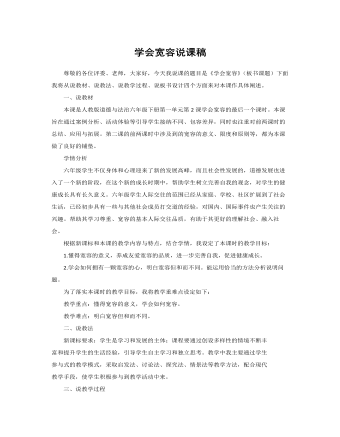
人教部编版道德与法制六年级下册学会宽容说课稿
①假如因为有第1条虫子,让我愤怒而无法黄谷他人,我会……②假如因为有第2条虫子,让我想要报复他人,我会……③假如因为有第3条虫子,让我不愿意原谅他人,我会……读一读,想一想。1.读P17案例。2.想一想:①案例1中,班主任的做法是否过于严厉,你认为冒犯他人人格和尊严的行为,可以宽容吗??②案例2中,如果小明的家人不严格要求小明,而是纵容他的玩火行为,可能会导致什么样的后果?活动三:和而不同读案例,谈体会。1.阅读pl8情景,分析原因。分析:六2班的战火因为什么而烧起来,这时班级的和谐有什么影响?2.谈体会。召开主题班会。1.召开班会:针对六2班出现的问题,班主任设计了“营建和谐宽容的班级生活”的主题班队活动,让我们一起参加吧。2.劝说:对于那些不宽容的观点,我们该怎么说服他们呢?教材3. 感悟:通过学习结合实践,谈谈你对宽容的理解。

人教部编版道德与法制六年级下册学会尊重说课稿
6.在我们生活中,同学之间难免会发生一些磕磕绊绊。下面,我们要观看一段视频,视频中小晨与小丰是形影不离的好朋友,一个星期天,两人与同学相约去学校排练班会上表演的一个节目。见时间还早,便下起了棋,下棋下出状况来了一一(播放视频)7.同学们,看了视频,发现是什么原因导致了这样的结果?8.如果你是他们中的一个,发生争执的时候心里只要怎么想,就可能避免发生这样的事呢?9.看来,尊重自己与接受别人的批评是不矛盾的。如果过于爱面子,输不起、说不得,就是过度维护自己。所以,尊重自己,就应该懂得适度维护自己。(板书:适度维护)10.以下哪些行为属于“尊重自己”?哪些属于“过度维护自己”?说说你的理由。(出示书本第七页“活动园”内容)四、总结升华。1.同学们,尊重是人与人交往的起点。尊重自己,需要悦纳自己,需要适度维护,它是一种美德,是人与人之间交流的另一种方式。希望每个同学都能懂得尊重自己,从而赢得别人对你的尊重。

